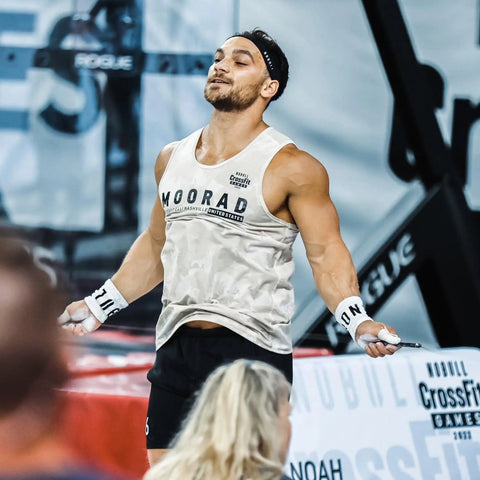10 Common Double Under Mistakes and How to Fix Them
May 20, 2022Jordan Lindstrom

How are you ever going to get to 100 doubles in a row if you can’t do 100 singles? Start with the basic movement in jump rope - the single jump - and only move on to double under training once you can do 100 single jumps in a row unbroken.

The proper length for double unders is determined by your ability level. We recommend sizing your rope by the clearance over your head.
The 6-10" is a more efficient length and preferred, but not practical for most jumpers. The idea is to get the rope turning around your body with as little effort as possible while maintaining maximum rope control. A jump rope that is too long will be sloppy and take too much effort to turn.
Note: A consequence of a jump rope that is too long is poor form: you move your hands out from your sides to spin the rope fast enough. When you size your rope down, you'll find you need to improve your form (hands by your sides).
The jump rope you choose should match the speed you are able to jump up and down for your double under height.
For example an accomplished young jumper can jump up and down very quickly. A cable speed rope is perfect for that. But a 50+ year old does not typically jump as fast and a speed cable rope may be too fast for them; by the time they land on the ground after the first jump, the rope is coming around and hits them before they are able to take off again.
A heavier rope (like a beaded rope) may be more beneficial and allow for more success. I have seen it happen where a 50 year old couldn’t do double under with a speed rope and tried the beaded rope and did 20 double unders in a row!
Here’s a good guide to the best double under speed ropes.

With double unders, consistency is important. Get your own rope so you can practice with the same one every time. I too often see people just grabbing the nearest rope at the gym, which not only is different from the last one they used, but isn't sized properly. Even slight changes can mess with your timing. Using the same rope will help your body and mind more quickly become familiar with the mechanics of the movement.
The biggest thing to keep in mind with double unders: it's all in the wrists. Don’t use your arms to spin the rope! This is the most common mistake people make. If you feel like you’re doing giant windmills with your arms, you’re doing it wrong. Practice rotating your wrists without the rope to get a feel for it.
Jump low - the cable is only 3/32" in diameter, and it spins fast, so you don’t need to take huge leaps. You'll wear your legs out too quickly jumping high.
Hands that move around (up & down, forward & back) while jumping cause inconsistency with your timing and rope spin. Work on keeping your hands still and in front of your hips.
The best hand placement is about 8" to 14" in front of your hips, with your hands fairly close to your sides (not flailing way out). This can be a challenge at first, especially if it feels uncomfortable, but with practice you'll find this is the most efficient placement.
Note: If your rope is too long (see #2) it will be very difficult to achieve this proper hand position, because you need to move your hands out to achieve the right arc in the rope for a quick spin. Proper rope length and hand position go "hand-in-hand".

Athletes that pike (legs come out straight in front) tend to hold their arms out straight, resulting in the need for a longer rope to accommodate the longer, straighter arms.

Athletes who turn their forearms down need a longer rope, as they are pushing the rope down to the ground each jump.

Kicking your feet back ("donkey kicking") is an easier problem to fix than pike jumping. Ask a few questions of yourself: Where is your gaze as you try to continue on from one to two doubles - up, down, forward? If someone was watching your bound (jump), does it increase in height after one double, or does it remain the same but with legs kicking back? Again if someone is watching you, can they report back to you to see if there is something changing in your arms after one double?

Relax! Doubles are a single with just an extra "flick"... Put in the practice and the effort, and you’ll be a double under pro in no time. If you’re more of a visual learner, here’s a tutorial video for anyone who is just getting started with double unders.
|
About the Author Matt Hopkins is a former competitive speed jumper and jump rope coach. Matt has won numerous national championships in speed jumping, and his athletes have won several national speed and freestyle titles and have broken world and national speed records. He also taught middle and elementary school PE in Leavenworth WA for 23 years. |
We're all about equipping and encouraging people to take on big challenges, because we know the process of doing hard things helps us grow in character and capacity.
Frequently bought together
You may also like
0 Comments
There are no comments for this article. Be the first one to leave a message!